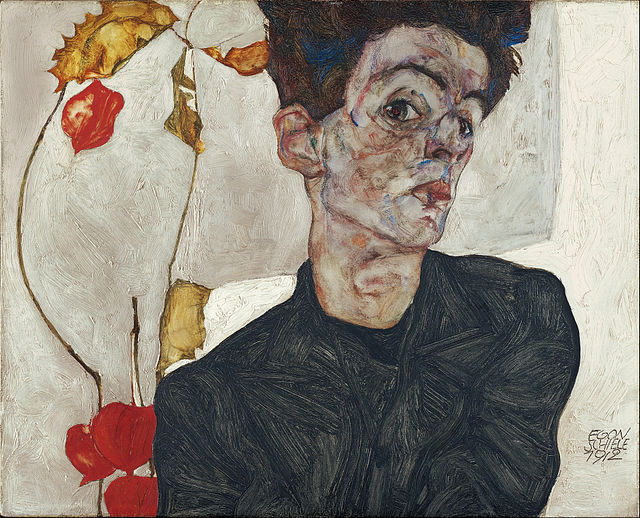Egon Leo Adolf Ludwig Schiele was an Austrian Expressionist painter. His work is noted for its intensity and its raw sexuality, and for the many self-portraits the artist produced, including nude self-portraits. The twisted body shapes and the expressive line that characterize Schiele's paintings and drawings mark the artist as an early exponent of Expressionism. Gustav Klimt, a figurative painter of the early 20th century, was a mentor to Schiele.
Self-Portrait with Physalis, 1912
Image: Signature Schiele 1917
Self-portrait, 1906 (aged 16)
Portrait of Arthur Rössler, 1910
A self-portrait is a portrait of an artist made by themselves. Although self-portraits have been made since the earliest times, the practice of self-portraiture only gaining momentum in the Early Renaissance in the mid-15th century that artists can be frequently identified depicting themselves as either the main subject, or as important characters in their work. With better and cheaper mirrors, and the advent of the panel portrait, many painters, sculptors and printmakers tried some form of self-portraiture. Portrait of a Man in a Turban by Jan van Eyck of 1433 may well be the earliest known panel self-portrait. He painted a separate portrait of his wife, and he belonged to the social group that had begun to commission portraits, already more common among wealthy Netherlanders than south of the Alps. The genre is venerable, but not until the Renaissance, with increased wealth and interest in the individual as a subject, did it become truly popular.

Vincent van Gogh, Self-portrait without beard, end September 1889, (F 525), Oil on canvas, 40 × 31 cm., Private collection. This may have been Van Gogh's last self-portrait. Given as a birthday gift to his mother.
Self-portrait by Judith Leyster, a Dutch Golden Age painter, mostly of genre subjects. NGA, 1630. In reality, she probably did not wear expensive clothes like these while painting.
Johannes Gumpp, 1646, shows how most self-portraits were painted.
Sandro Botticelli's 1475 painting of the Adoration of the Magi has an "inserted self-portrait". The position in the (right) corner, and the gaze out to the viewer, are very typical of such self-portraits.








